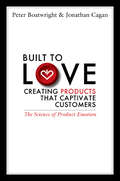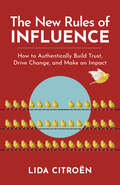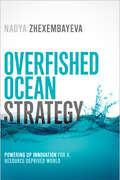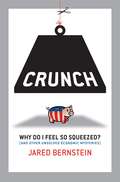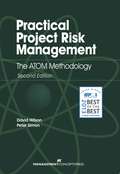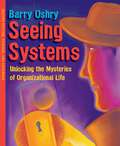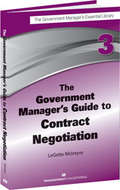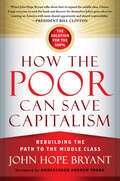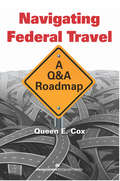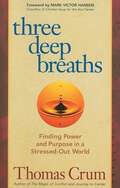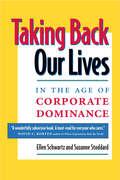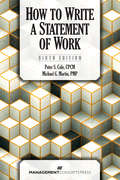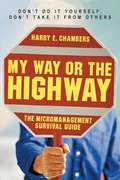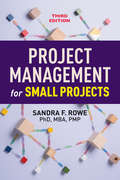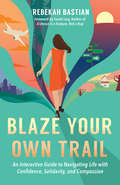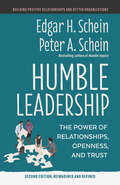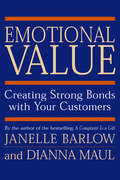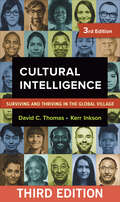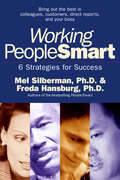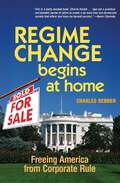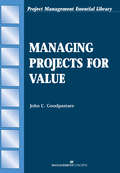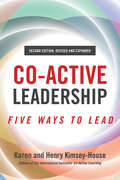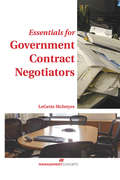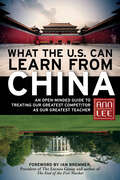- Table View
- List View
Built to Love: Creating Products That Captivate Customers
by Jonathan Cagan Peter BoatwrightOffers data-driven proof that products and services appealing to customer’s emotional needs outsell the competition Provides a clear method and set of tools to enable companies to develop high emotion products and services Includes case examples from a wide variety of industries Emotion is the single greatest lever in building enduring relationships with customers—it’s what makes them not just purchase a product or service, but get excited about it. Leading companies do more than produce things that work better. They address their customers’ emotional needs—they make them feel better. But this isn’t something you can add on after the fact. Your products and services must be built to love from the very start. This book shows you how. Peter Boatwright and Jonathan Cagan have worked on product and brand strategy with market leaders like Apple, Whirlpool, International Truck, PG&E, and many others. They’ve found that to really connect with customers emotions must be generated by the product itself, not simply tacked on through advertising. And they prove the bottom-line value of product-driven emotion by analyzing the stock performance of companies that sell high-emotion products and through data that show people are willing to pay more for products with emotionally-rich features. After showing that authentic product emotion really does pay off, they move on to how—how emotion can be broken down into its core building blocks, how it is then used to develop new products and services, and how product touchpoints —in particular visual touchpoints — deliver those emotions. Engaging case studies from a variety of industries will help you understand how to integrate emotion into your products and services, regardless of the nature of your business. Emotion is fundamental to all that is human, including the products we enjoy. Built to Love will help you gain loyal, even fanatical customers by going beyond mere efficiency and speaking to their deepest needs and wants.
The New Rules of Influence: How to Authentically Build Trust, Drive Change, and Make an Impact
by Lida CitroënLeave the power tie at home. The old rules of influence don't work anymore.It's time to throw out the old rules of influence and become the leader you've always wanted to be.A new type of leader is emerging—one with a bold mission who empowers others through transparency and unwavering passion. Modern-day executive presence mandates levels of authenticity and honesty never before seen in the C-suite.Personal branding and reputation management expert, Lida Citroën guides leaders through this new paradigm of executive presence and influence. Through inspiring examples, compelling stories, and practical exercises, Citroën helps leaders tap into their passion, connect authentically with others, and create space for inclusivity and community.Greta Thunberg is a powerful example of a new paradigm leader. The Swedish teenager's influence arguably exceeds that of most CEOs or political leaders. The youngest person to be named Time's Person of the Year, she radically upended Swedish politics and world climate policy. Nothing about her conforms to the typical expectations of a leader's executive presence—her power comes from her absolute honesty and genuine passion to make the world a better place.
Overfished Ocean Strategy: Powering Up Innovation for a Resource-Deprived World
by Nadya ZhexembayevaWe all know the proverb about teaching someone to fish, but if there are no fish left, knowing how to catch them won&’t do you any good. And that&’s the position businesses are in today. Resources are being depleted at an alarming rate and the cost of raw materials is rising dramatically. As a result, scholar and entrepreneur Nadya Zhexembayeva says, businesses need to make resource scarcity—the overfished ocean—their primary strategic consideration, not just a concern for their &“green&” division. Overfished Ocean Strategyoffers five essential principles for innovating in this new reality. Zhexembayeva shows how businesses can find new opportunities in what were once considered useless by-products, discover resource-conserving efficiencies up and down their value chain, transfer their expertise from physical products to services, and develop ways to rapidly try out and refine these new business models. She fills the book with examples of companies that are already successfully navigating the overfished ocean, from established corporations such as BMW, Microsoft, and Puma to newcomers such as Lush, FLOOW2, and Sourcemap. The linear, throwaway economy of today—in which we extract resources at one end, create products, and throw them away at the other—is rapidly coming to an end. In every industry, creative minds are learning how to make money by taking this line and turning it into a circle. Nadya Zhexembayeva shows how you can join them and avoid being left high and dry.
Crunch: Why Do I Feel So Squeezed? (and Other Unsolved Economic Mysteries)
by Jared BernsteinIs Social Security really going bust, and what does that mean to me? If I hire an immigrant, am I hurting a native-born worker? Why does the stock market go up when employment declines? Should I give that homeless guy a buck? What’s a “living wage”? How much can presidents really affect economic outcomes? What does the Federal Reserve Bank really do? And even when some pundits say the economy’s sound, why do I still feel so squeezed? If you’d like some straight answers, premier economist Jared Bernstein is here to help. In Crunch he responds to dozens of questions he has fielded from working Americans, questions that directly relate to the bottom-line, dollars-and-cents concerns of real people. Chances are if there’s a stumper you’ve always wanted to ask an economist, it’s solved in this book. Bernstein is fed up with “Darth Vaders with PhDs” who use their supposed expertise to intimidate average citizens and turn economics into a tool for the rich and powerful. In the pages of Crunch, Bernstein lays bare the dark secret of economics: it’s not an objective scientific discipline. It’s a set of decisions about the best way to organize our society to produce and distribute resources and opportunities. And we all can, and must, participate in these decisions. “America is a democracy,” he writes. “And in a democracy all of us, not just the elites and their scholarly shock troops, get to weigh in on biggies like this.” To not weigh in, Bernstein insists, is a profoundly political act, one with damaging consequences. Our economy will be only as fair as we can make it. In this lively and irreverent tour through everyday economic mysteries, Bernstein helps us decode economic “analysis,” navigate through murky ethical quandaries, and make sound economicdecisions that reflect our deepest aspirations for ourselves, our families, and our country.
Practical Project Risk Management: The ATOM Methodology
by David HillsonThis second edition of the book reflects the authors' work to continually improve upon the model and to apply the methodology to a broader range of issues. The book includes:• An entirely new chapter on managing risk in programs, which is an important dimension in today's world of ever more complex initiatives• Updated material and methodology more closely aligned with relevant international standards• Emphasis on minimizing the threats and maximizing the opportunities to optimize achievement of your project goalsBased on sound principles and best practices, this book guides any member of the project management team in conducting risk management in a real-world environment.
Seeing Systems: Unlocking the Mysteries of Organizational Life
by Barry OshryWhen breakdowns occur in organizational life, the tendency is to blame them on the personalities, motivations, and abilities of the individuals involved or on the specific characteristics of one’s organization. Barry Oshry demonstrates how everyday breakdowns stem from our failure to see how human systems shape our feelings about ourselves and our relationships with other individuals and groups. He shows how we can transform “system blindness” into system sight, enabling us to live and work together in productive partnership. Based on Oshry’s 30+ years of studying human interaction in social system life, Seeing Systems is profound in its implications while being easily accessible. In addition to illustrative cases and solid systems theory, the book is populated with pinballs; talking body parts; mysterious “swimmers”; amebocytes, slugs, and earthworms; dances of blind reflex; and tunnels of limited options. The result is a unique foundation for revolutionizing our understanding of system life. This new edition is revised throughout and features an extensive new section on having the wisdom and courage to face and work with the reality of uncertainty, a hopeful antidote to today’s righteous battles of certainty versus certainty. The new epilogue describes how Oshry is currently using theater, blogs, and podcasts to extend his multipronged revolution aimed at transforming system blindness into system sight.
The Government Manager's Guide to Contract Negotiation
by Legette McIntyreThe Government Manager's Guide to Contract Negotiation Federal managers often find themselves at the negotiating table, charged with reaching a solid, fair deal for their agency. Now, you can gain a competitive edge in even the most difficult negotiations with time-tested, effective tactics from a noted authority on federal negotiations. This guide will help you understand the negotiation process, plan for it, develop strategies and tactics, anticipate and counter the other side's strategies and tactics, and conclude and document the negotiation. Concise, accessible, and authoritative, this book offers a veritable arsenal of winning strategies that you and your team can use in your next negotiation.
Understanding Government Contract Law
by Terrence M. O'ConnorA "back-to-basics" guide to government contract lawFinally! A plain-English presentation of the basic legal concepts of government contract law for professionals at any stage in their careers.Until now, anyone in the procurement field has had to trudge through dense and complex texts written in hard-to-follow "legalese" in their quest to understand procurement law. With Understanding Government Contract Law, they finally have a source of clear and concise explanations of the legal principles involved in government contract law, written by an authority on the subject.Part I of the book focuses on the unique problems facing each of the parties to a government contract – the contract officer and the contractor – and offers insight to the many roles played by the contract officer in the procurement process. Part II describes why and how the government contract is different from commercial contracts. Part III explores the ins and outs of a government contract lawsuit.The author presents key legal principles of government contract law by:• Stating a legal principle• Specifying where in the Federal Acquisition Regulation (FAR) that principle is found• Offering the rationale, context, and any public policy behind the principle• Describing, with case law examples, situations where the government applied the law correctly and situations where the government came to that conclusion incorrectly
How the Poor Can Save Capitalism: Rebuilding the Path to the Middle Class
by John Hope BryantJohn Hope Bryant, successful self-made businessman and founder of the nonprofit Operation HOPE, says business and political leaders are ignoring the one force that could truly re-energize the stalled American economy: the poor. If we give poor communities the right tools, policies, and inspiration, he argues, they will be able to lift themselves up into the middle class and become a new generation of customers and entrepreneurs. Raised in poverty-stricken, gang-infested South Central Los Angeles, Bryant saw firsthand how our institutions have abandoned the poor. He details how business loans, home loans, and financial investments have vanished from their communities. After decades of deprivation, the poor lack bank accounts, decent credit scores, and any real firsthand experience of how a healthy free enterprise system functions. Bryant radically redefines the meaning of poverty and wealth. (It's not just a question of finances; it's values too.) He exposes why attempts to aid the poor so far have fallen short and offers a way forward: the HOPE Plan, a series of straightforward, actionable steps to build financial literacy and expand opportunity so that the poor can join the middle class. Fully 70 percent of the American economy is driven by consumer spending, but more and more people have too much month at the end of their money. John Hope Bryant aspires to "expand the philosophy of free enterprise to include all of God's children" and create a thriving economy that works not just for the 1 percent or even the 99 percent but for the 100 percent. This is a free enterprise approach to solving the problem of poverty and raising up a new America.
Navigating Federal Travel: A Q&A Roadmap
by Queen E. CoxGet the right directions for federal travel!Don't get lost in the tangled web of rules and regulations governing federal travel. Make sure you have the one guide that will put you on the road to being a knowledgeable and compliant government traveler— Navigating Federal Travel: A Q & A Roadmap.This essential reference is geared not only to government travelers and those authorizing and approving travel, but also to those who provide travel management services to government agencies. The guide is organized in question-and-answer format, similar to the Federal Travel Regulation (FTR), and is presented to be readily accessible and informative.The information is based on the author's years of experience as a federal travel manager as well as the FTR, Government Accountability Office and Civilian Board of Contract Appeals decisions, and pertinent legislation and mandates. As a supplement to the FTR, the guide includes examples of actual and potential situations the traveler may encounter before, during, and after approval of authorized travel.The book offers clear and concise information on:• How to determine the need for travel• How travel is authorized and by whom• How the employee pays for expenses incurred in performing official travel• How the employee is reimbursed for authorized travel and travel-related expenses.Navigating Federal Travel also includes coverage of best practices for the Agency/Organization Program Coordinator (A/OPC), who is responsible for managing the government travel charge card program. Appendices offer helpful websites and resources as well as special information for relocation.Get the right directions and follow the rules with Navigating Federal Travel: A Q & A Roadmap.
Three Deep Breaths: Finding Power and Purpose in a Stressed-Out World (Bk Life. Ser.)
by Thomas CrumThese days all of us lead hectic, stressful lives. And most of us react to difficult circumstances by struggling against them, which only creates more tension. Three Deep Breaths provides a welcome alternative--a simple technique that you can use, no matter how busy you are, to transform tough situations into positive, energizing experiences. It is a mind/body technique that combines the "cognitive-restructuring" capability of the brain (the ability to change our attitudes and perceptions of the world) with the calmness and presence of an aligned, centered state of being. Thomas Crum illustrates this radically simple technique through the story of Angus, who is struggling to break through the negative habits that lead to anger, exhaustion, and poor performance. We follow Angus as he learns to use the Three Deep Breaths to maintain clarity and purpose in the midst of seeming chaos, to redirect negative energy to more positive purposes. By working with our breath, by being aware of it and using it as a focusing tool, we can open up a whole new world of possibility. The quality of our lives depends not on whether or not we have conflicts but on how we respond to them. All it takes to change your life is Three Deep Breaths--which you can do in an instant, anywhere, at any time.
Taking Back Our Lives in the Age of Corporate Dominance
by Suzanne Stoddard Ellen AugustineReveals the profound impact of the global corporate economy on our daily lives Details 75 immediate and long-term Action Steps for empowering ourselves both individually and as a society Offers specific tips, ideas, and resources on how to pare down our lives and open up our time Provides questions for reflection that help readers to think in new ways about what matters most to them Corporate structures, products, and processes permeate our society -but what do they really mean to us in our daily lives? The bottom-line mentality that drives corporate America, say Ellen Augustine (formerly Schwartz) and Suzanne Stoddard, is creating a world unresponsive to human needs, corrosive to the democratic process, and destructive to the planet itself. Taking Back Our Lives in the Age of Corporate Dominance shows the links between our mundane everyday struggles and the global corporate economy, image-driven media, and the relentless pace which consumes us all. And it tells us how we can change things by transforming both our work and leisure. The authors use hard-hitting examples and illuminating personal vignettes about confronting fear, anger, death, family problems, and the stultifying effects of staying in the "comfort zone." They detail over 75 steps for personal and societal actions-some quick and immediate, others in-depth and long term-for retaking control of our lives. The authors include provocative questions for reflection that shock, prod, and jump-start the reader into thinking about what matters most to them. Deeply moving, outrageous, encouraging, compelling, and inspiring, Taking Back Our Lives in the Age of Corporate Dominance blends unrelenting candor with the comfort of real-life stories of hope-and ultimately shows us that choice is the most important tool we have for reviving our lives and our world.
How to Write a Statement of Work
by Michael G. Martin PMP Peter S. Cole CPCMThe standard on government statements of work just got better!How to Write a Statement of Work has been a standard reference for government employees and contractors for many years. Now, with this sixth edition, it is even more relevant and useful. Based on the excellent foundation laid by the late Peter Cole, Michael Martin has updated and added material to guarantee this handbook's place in the list of "must haves" for working with government contracts. As in the earlier editions, the emphasis is on providing practical, detailed guidance on writing and preparing a description of government requirements, whether a statement of work (SOW), a performance work statement (PWS), or a statement of objectives (SOO).Among the many additions to this sixth edition are updates to reflect the current definition of an SOO as well as references and guidance regarding the development and application of the SOO. There is a new chapter on why change management is so important on projects, legal precedents supporting change management, and how to identify when a change occurs using the SOW. This new chapter also includes information on the federal government's Standard Form 30 (SF30) to provide perspective on how change orders are used and applied in the federal government. If you are working in government contracting in any capacity, you should have this book on hand!
My Way or the Highway: The Micromanagement Survival Guide
by Harry E. ChambersBy the author of the bestselling Bad Attitude Survival Guide (more than 40,000 copies sold), named one of the top business books of 1998 by Executive Book Summaries Everyone thinks they know what micromanagement is, but this book presents a specific, detailed definition illustrated with concrete examples Offers successful strategies for overcoming your own micromanaging behavior and for responding when you are being micromanaged Micromanagement is one of the most widely condemned managerial sins, and one of the most common employee complaints. It results in significant direct, indirect, and hidden costs to organizations, contributing to low morale, high turnover, inefficiency, instability, and lack of continuity. And being perceived as a micromanager can have a significant negative impact on your career. But what, precisely, is micromanagement? More importantly, what can be done about it? In My Way or the Highway, Harry Chambers proves that micromanagement can be objectively identified and successfully resisted, both by those who (often unknowingly) inflict it and by those who are its victims. In an informal, entertaining style Chambers describes five specific defining traits of micromanagers: placing their own self interest above everything else; controlling and manipulating time; attempting to determine exactly how everything must be done; requiring elaborate approval processes; and establishing dysfunctional monitoring and reporting requirements. He even provides a Micromanagement Potential Indicator test so you can see whether (and to what extent) you might be a micromanager. He then devotes a chapter to each trait, providing real-world examples of the trait in action and an analysis of the damage it does. But this is not just a book of diagnosis-Chambers provides treatment as well. He devotes several chapters how to respond if you are the micromanagee (a victim of micromanagement), how to eliminate your own micromanaging behaviors, and what to do if you have to manage a micromanager. Avoiding micromanagement should be a major goal of every manager, would-be manager, team member, or collaborative peer. My Way or the Highway offers detailed, actionable, field-tested strategies that will eliminate the damage that overcontrolling behavior causes and increase creativity, risk-taking, productivity, and initiative in any organization.
Project Management for Small Projects, Third Edition
by Sandra F. RoweProject Management for Small Projects shows you how to tailor bureaucratic planning processes to a sleek minimum while still keeping your project running like a well-oiled machine.The Project Management Body of Knowledge (PMBOK) recommends tailoring the planning processes to fit the size of your project, but it doesn't always fully explain how. Using too much process can be as detrimental to a project as not using a process at all. For years, this book has helped managers of small projects design processes that are neither too big nor too small but "just right." It provides simplified but compliant tools for immediate use in managing small projects. And since most small projects tend to be similar in structure or outcome, a template for one project can be used for future projects. This new edition of Project Management for Small Projects has been updated to align with the latest PMBOK. In addition, there is new material on Agile project management and on the essential leadership skills for small project managers.
Blaze Your Own Trail: An Interactive Guide to Navigating Life with Confidence, Solidarity, and Compassion
by Rebekah BastianA modern, feminist take on the classic choose-your-own-journey book, inspiring readers to embrace the fact that there is no singular right path—just your own! So many women enter their adult lives believing that they should know where they are going and how to get there. This can make life decisions feel intimidating and overwhelming. While some choices that lie ahead are fairly predictable, such as those surrounding career, partnership, and motherhood, the effects of these choices can lead to more complicated and unexpected turns that are seldom discussed.Rather than suggesting a rule book, Rebekah Bastian, vice president at Zillow and recognized thought leader, inspires you to Blaze Your Own Trail. "I have the benefit of being a living example of crooked paths, magnificent screw-ups, and shocking successes," she writes. Through storylines and supportive data that explore workplace sexism, career changes, marriage, child-rearing, existential crises, and everything in between, you will learn to embrace and feel less alone in your own nonlinear journey. Even better, you can turn back decisions and make different ones. Blaze Your Own Trail includes nineteen possible outcomes and many routes to get there. You will find that you have the strength to make it through any of them.
Humble Leadership, Second Edition: The Power of Relationships, Openness, and Trust
by Edgar H. Schein Peter A. ScheinDiscover a more agile, democratic, and effective model of leadership, from legendary business scholar Edgar Schein and Silicon Valley executive Peter Schein.Legendary organizational scholar Edgar Schein and former Silicon Valley executive Peter Schein say leadership today requires that people transcend their hierarchical roles and relate to each other as human beings-what they call humble leadership. In such relationships new ideas can flow freely, mistakes can come to light immediately, and course corrections can be made in real time rather than by committee or by order of the lone heroic CEO.This second edition includes three new chapters. Chapter 1 zeros-in on the Schein's actionable definition of leadership-relative to management and administration-focused on leading people toward new and better. Chapter 2 introduces the concept of situational humility-leaders now need to shift between several types of relationships to deal with the accelerating complexity of a supply-constrained, quiet-quitting, and two-days-in-the-office world. And Chapter 5 explains how to create a culture of humble leadership. Illustrated with examples from healthcare, government, the military, tech, and more, this is a compact, accessible guide to a leadership paradigm far better suited to a world that demands fast, nimble response to change, and a workplace hungry for mutual respect and trust.
Emotional Value: Creating Strong Bonds with Your Customers
by Janelle Barlow Dianna MaulToday's consumers demand not only services and products that are of the highest quality, but also positive, memorable experiences. This essential guide shows how organizations can leapfrog their competitors by learning how to add emotional value -the economic value of customers' feelings when they positively experience products and services -to their customers' experiences. Janelle Barlow and Dianna Maul, with more than forty years combined experience in the service industry, detail five practices for adding emotional value to customer and staff experiences.
Cultural Intelligence: Surviving and Thriving in the Global Village
by David C. Thomas Kerr C. InksonSucceed in Any Culture, in Every Situation In today's global economy, the ability to interact effectively across cultures is a fundamental job requirement for just about everyone. But it's impossible to learn the customs and traits of every single culture. David Thomas and Kerr Inkson present a universal set of techniques and people skills that will allow you to adapt quickly to, and thrive in, any cultural environment. You'll learn to discard your own culturally based assumptions and pay careful attention, in a mindful and creative way, to cues in cross-cultural situations. The authors show how to apply cultural intelligence in a series of specific situations: making decisions; communicating, negotiating, and resolving conflicts; leading and motivating others; and designing, managing, and contributing to multicultural groups and teams. This extensively revised third edition has been updated with new stories showing cultural intelligence in action. Thomas and Inkson have broadened the focus beyond business to include organizations of all kinds—nonprofits, governments, educational institutions, and more. And they include a reliable and valid measure of cultural intelligence based on a decade of research by an international team of scholars.
Working PeopleSmart: 6 Strategies for Success
by Mel Silberman Freda HansburgBringing out the best in others is good business. When we bring both respect and interpersonal savvy to our work relationships, we do more than make people feel good. We enhance personal and organizational performance. And as the workplace grows more complex and competitive, managing our work relationships becomes even more essential and difficult. Now more than ever we need to work people smart. Working PeopleSmart describes the six core strategies used by people-smart individuals and shows how to apply them in the toughest workplace situations. Individuals who are people smart know how to open others up rather than make them defensive or resistant. They have a knack for diffusing tension rather than creating it. They set a good example through their own behavior on the job and can inspire and influence others with less developed skills. Working PeopleSmart can serve as your virtual coach to guide you through difficult work relationships skillfully. How do you deal with a critical colleague? Make your boss listen to you? React to an offensive joke? Get the resources you need? The authors look at over 50 real-life situations and offer people-smart prescriptions for handling them effectively. They provide coaching tips for each scenario and describe exactly what a people-smart response sounds like. As two psychologists with both organizational and clinical expertise, coauthors Mel Silberman and Freda Hansburg are highly qualified to deliver the message that we can emerge from even the toughest interpersonal moments on the job with dignity and grace. Where other books rely on typologies that categorize people according to their interpersonal styles and then offer advice on how to deal with each type, the strategies described in Working PeopleSmart are straightforward and universal. They can be used immediately to deal with any type of person or any situation, no matter how difficult or sensitive.
Regime Change Begins at Home: Freeing America from Corporate Rule
by Charles DerberSince 1980, America has been run by a corporate regime that has co-opted both political parties and shifted sovereignty from "we the people" to trans-national corporations. The result has been job insecurity for millions of workers, debts as far as the eye can see, and a dangerous quest for global domination. Democracy itself has been undermined and the Constitution weakened. This regime must be overturned! And, as Charles Derber demonstrates in his provocative new book, it can be. After all, Derber points out, there have been other corporate regimes in American history, although this latest version is by far the most extreme. Still, the corporate regimes of the Gilded Age and Roaring Twenties were overturned. To create regime change again, it will require bold, creative strategies, uniting progressives and conservatives in a new politics, which Derber outlines in detail. Regime Change Begins at Home exposes the many lies the corporate regime has used to maintain itself throughout its history, from the Cold War to the Iraq war, with a particular emphasis on how the Bush administration has cynically sought to, as Condelezza Rice once put it, "capitalize on the opportunities" presented by 9/11. Derber reveals how the Bush administration has used the so-called "war on terror" to frighten and distract the public. But regime change is possible. In Part III, Derber lays out the vision of a new regime, describing the social movements now fighting to achieve it, and the major new political realignment-one spanning the traditional conservative-liberal divide-that can make it happen. Derber does not minimize the difficulty of the task ahead, but he offers hope and specific, sophisticated, often surprising advice for defeating the regime and returning America to its citizens.
Managing Projects for Value
by John C. Goodpasture PMPWith a clear focus on how business objectives determine project value, this book explains how to use an "investment-based" perspective to integrate finance, risk management and strategic planning. You'll develop workflows that overcome constraints of time, cost and scheduling as you benefit from new tools that relate processes directly to business goals: the project balance sheet and the time-centric earned value system. In addition, a new goal decomposition methodology gives you the best chance of getting projects started - and getting them accomplished successfully.
Co-Active Leadership, Second Edition: Five Ways to Lead
by Henry Kimsey-House Karen Kimsey-HouseAs leaders, how we are is as important as what we do. The second edition of this leadership classic, updated with new chapters, shows how to master the inner and outer work needed to build relationships that unleash the transformational creative potential in everyone.We need to expand beyond top-down, one-dimensional leadership models and find alternatives that are more fluid and inclusive and that harness the possibility of many rather than relying on the power of one. This is exactly what Karen and Henry Kimsey-House provide in this groundbreaking book. Co-Active Leadership is a deeply collaborative approach, which is why the first of its five dimensions is leading from within: self-leadership. Leaders must be fully present and live lives of integrity, openheartedness, and self-awareness if they are to make the kind of conscious, creative choices Co-Active Leadership demands.Each of the remaining four dimensions work together holistically. Depending on the situation, you may lead from the front, offering guidance and inspiration; from behind, supporting and encouraging others; from beside, partnering with and supporting other members of your team; or from the field, drawing on insights and wisdom available beyond the rational mind.This edition includes two new chapters, one offering new ways to utilize the Co-Active Leadership Model and another that goes deeply into the Co-Active philosophy. Co-Active Leadership celebrates and honors different expressions of leadership. It invites all of us to share our expertise and allows collaborative solutions to emerge that would never have been possible otherwise.
Essentials for Government Contract Negotiators
by Legette McIntyreLearn to negotiate by applying business-savvy negotiation strategies and tactics, anticipating and countering the other side's strategies and tactics, and concluding and documenting the negotiation successfully. Essentials for Government Contract Negotiators focuses on the distinctive aspects of government negotiations, helping you hold your own in an actual, sit-down negotiation session with a skilled counterpart. With this book you will learn to:• Select and apply negotiation skills in a government-unique environment to achieve a true-best value result• Develop a negotiation plan, including your BATNA• Recognize less-than-ethical tactics and be prepared to counter them• Properly conclude and document the negotiation• Use acquisition histories to gather appropriate data• Manage challengesFacilitate better negotiation outcomes
What the U.S. Can Learn from China: An Open-Minded Guide to Treating Our Greatest Competitor as Our Greatest Teacher
by Ann LeeWhile America is still reeling from the 2008 financial crisis, a high unemployment rate, and a surge in government debt, China’s economy is the second largest in the world, and many predict it will surpass the United States’ by 2020. President Obama called China’s rise “a Sputnik moment”—will America seize this moment or continue to treat China as its scapegoat? Mainstream media and the U.S. government regularly target China as a threat. Rather than viewing China’s power, influence, and contributions to the global economy in a negative light, Ann Lee asks, What can America learn from its competition? Why did China recover so quickly after the global economic meltdown? What accounts for China’s extraordinary growth, despite one of the highest corporate tax rates in the world? How does the Chinese political system avoid partisan rancor but achieve genuine public accountability? From education to governance to foreign aid, Lee details the policies and practices that have made China a global power and then isolates the ways the United States can use China’s enduring principles to foster much-needed change at home. This is no whitewash. Lee is fully aware of China’s shortcomings, particularly in the area of human rights. She has relatives who suffered during the Cultural Revolution. But by overemphasizing our differences with China, the United States stands to miss a vital opportunity. Filled with sharp insights and thorough research, What the U.S. Can Learn from China is Lee’s rallying cry for a new approach at a time when learning from one another is the key to surviving and thriving.
